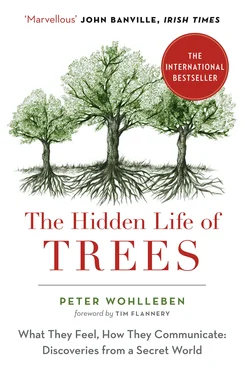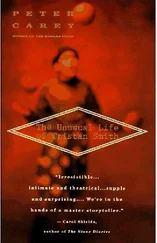Communication between trees and insects doesn’t have to be all about defense and illness. Thanks to your sense of smell, you’ve probably picked up on many feel-good messages exchanged between these distinctly different life-forms. I am referring to the pleasantly perfumed invitations sent out by tree blossoms. Blossoms do not release scent at random or to please us. Fruit trees, willows, and chestnuts use their olfactory missives to draw attention to themselves and invite passing bees to sate themselves. Sweet nectar, a sugar-rich liquid, is the reward the insects get in exchange for the incidental dusting they receive while they visit. The form and color of blossoms are signals, as well. They act somewhat like a billboard that stands out against the general green of the tree canopy and points the way to a snack.
So trees communicate by means of olfactory, visual, and electrical signals. (The electrical signals travel via a form of nerve cell at the tips of the roots.) What about sounds? Let’s get back to hearing and speech. When I said at the beginning of this chapter that trees are definitely silent, the latest scientific research casts doubt even on this statement. Along with colleagues from Bristol and Florence, Dr. Monica Gagliano from the University of Western Australia has, quite literally, had her ear to the ground. 13It’s not practical to study trees in the laboratory; therefore, researchers substitute grain seedlings because they are easier to handle. They started listening, and it didn’t take them long to discover that their measuring apparatus was registering roots crackling quietly at a frequency of 220 hertz. Crackling roots? That doesn’t necessarily mean anything. After all, even dead wood crackles when it’s burned in a stove. But the noises discovered in the laboratory caused the researchers to sit up and pay attention. For the roots of seedlings not directly involved in the experiment reacted. Whenever the seedlings’ roots were exposed to a crackling at 220 hertz, they oriented their tips in that direction. That means the grasses were registering this frequency, so it makes sense to say they “heard” it.
Plants communicating by means of sound waves? That makes me curious to know more, because people also communicate using sound waves. Might this be a key to getting to know trees better? To say nothing of what it would mean if we could hear whether all was well with beeches, oaks, and pines, or whether something was up. Unfortunately, we are not that far advanced, and research in this field is just beginning. But if you hear a light crackling the next time you take a walk in the forest, perhaps it won’t be just the wind ...
3 3 / Social Security 4 / Love 5 / The Tree Lottery 6 / Slowly Does It 7 / Forest Etiquette 8 / Tree School 9 / United We Stand, Divided We Fall 10 / The Mysteries of Moving Water 11 / Trees Aging Gracefully 12 / Mighty Oak or Mighty Wimp? 13 / Specialists 14 / Tree or Not Tree? 15 / In the Realm of Darkness 16 / Carbon Dioxide Vacuums 17 / Woody Climate Control 18 / The Forest as Water Pump 19 / Yours or Mine? 20 / Community Housing Projects 21 / Mother Ships of Biodiversity 22 / Hibernation 23 / A Sense of Time 24 / A Question of Character 25 / The Sick Tree 26 / Let There Be Light 27 / Street Kids 28 / Burnout 29 / Destination North! 30 / Tough Customers 31 / Turbulent Times 32 / Immigrants 33 / Healthy Forest Air 34 / Why Is the Forest Green? 35 / Set Free 36 / More Than Just a Commodity Note from a Forest Scientist by Dr. Suzanne Simard Notes Index Acknowledgments About the Publisher
— SOCIAL SECURITY — 3 / Social Security 4 / Love 5 / The Tree Lottery 6 / Slowly Does It 7 / Forest Etiquette 8 / Tree School 9 / United We Stand, Divided We Fall 10 / The Mysteries of Moving Water 11 / Trees Aging Gracefully 12 / Mighty Oak or Mighty Wimp? 13 / Specialists 14 / Tree or Not Tree? 15 / In the Realm of Darkness 16 / Carbon Dioxide Vacuums 17 / Woody Climate Control 18 / The Forest as Water Pump 19 / Yours or Mine? 20 / Community Housing Projects 21 / Mother Ships of Biodiversity 22 / Hibernation 23 / A Sense of Time 24 / A Question of Character 25 / The Sick Tree 26 / Let There Be Light 27 / Street Kids 28 / Burnout 29 / Destination North! 30 / Tough Customers 31 / Turbulent Times 32 / Immigrants 33 / Healthy Forest Air 34 / Why Is the Forest Green? 35 / Set Free 36 / More Than Just a Commodity Note from a Forest Scientist by Dr. Suzanne Simard Notes Index Acknowledgments About the Publisher
GARDENERS OFTEN ASK me if their trees are growing too close together. Won’t they deprive each other of light and water? This concern comes from the forestry industry. In commercial forests, trees are supposed to grow thick trunks and be harvest-ready as quickly as possible. And to do that, they need a lot of space and large, symmetrical, rounded crowns. In regular five-year cycles, any supposed competition is cut down so that the remaining trees are free to grow. Because these trees will never grow old—they are destined for the sawmill when they are only about a hundred—the negative effects of this management practice are barely noticeable.
What negative effects? Doesn’t it sound logical that a tree will grow better if bothersome competitors are removed so that there’s plenty of sunlight available for its crown and plenty of water for its roots? And for trees belonging to different species that is indeed the case. They really do struggle with each other for local resources. But it’s different for trees of the same species. I’ve already mentioned that beeches are capable of friendship and go so far as to feed each other. It is obviously not in a forest’s best interest to lose its weaker members. If that were to happen, it would leave gaps that would disrupt the forest’s sensitive microclimate with its dim light and high humidity. If it weren’t for the gap issue, every tree could develop freely and lead its own life. I say “could” because beeches, at least, seem to set a great deal of store by sharing resources.
Students at the Institute for Environmental Research at RWTH Aachen discovered something amazing about photosynthesis in undisturbed beech forests. Apparently, the trees synchronize their performance so that they are all equally successful. And that is not what one would expect. Each beech tree grows in a unique location, and conditions can vary greatly in just a few yards. The soil can be stony or loose. It can retain a great deal of water or almost no water. It can be full of nutrients or extremely barren. Accordingly, each tree experiences different growing conditions; therefore, each tree grows more quickly or more slowly and produces more or less sugar or wood, and thus you would expect every tree to be photosynthesizing at a different rate.
And that’s what makes the research results so astounding. The rate of photosynthesis is the same for all the trees. The trees, it seems, are equalizing differences between the strong and the weak. Whether they are thick or thin, all members of the same species are using light to produce the same amount of sugar per leaf. This equalization is taking place underground through the roots. There’s obviously a lively exchange going on down there. Whoever has an abundance of sugar hands some over; whoever is running short gets help. Once again, fungi are involved. Their enormous networks act as gigantic redistribution mechanisms. It’s a bit like the way social security systems operate to ensure individual members of society don’t fall too far behind. 14
In such a system, it is not possible for the trees to grow too close to each other. Quite the opposite. Huddling together is desirable and the trunks are often spaced no more than 3 feet apart. Because of this, the crowns remain small and cramped, and even many foresters believe this is not good for the trees. Therefore, the trees are spaced out through felling, meaning that supposedly excess trees are removed. However, colleagues from Lübeck in northern Germany have discovered that a beech forest is more productive when the trees are packed together. A clear annual increase in biomass, above all wood, is proof of the health of the forest throng. 15
Читать дальше












